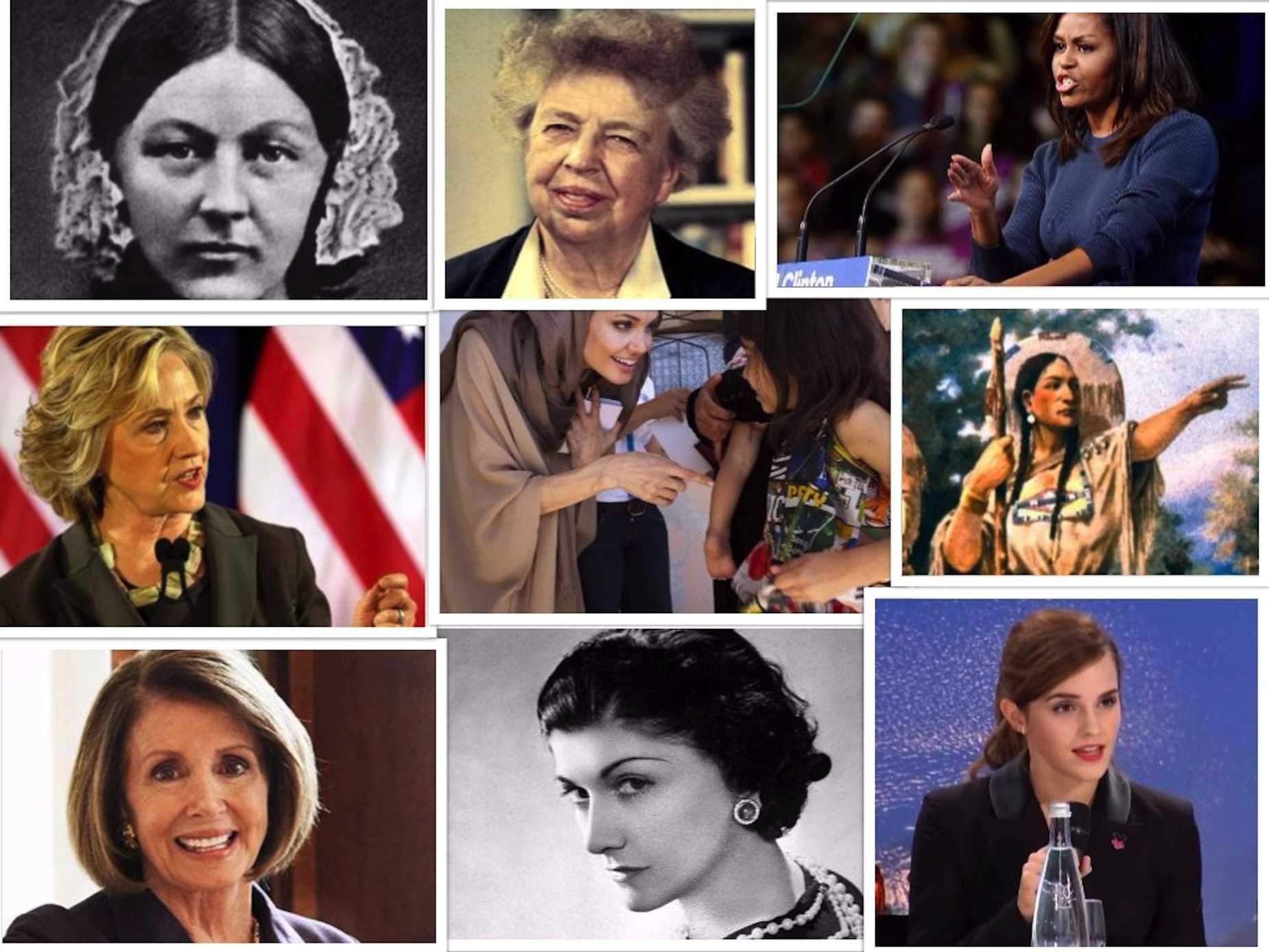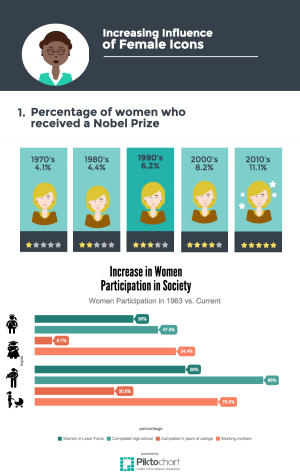Your donation will support the student journalists of North Cobb High School. Your contribution will allow us to purchase equipment and cover our annual website hosting costs.
A girl like me: Young women search for female role models
December 19, 2016
Young women often struggle with finding a place in this world for themselves. A place where girls successfully thrive, looking after other female icons to provide them with aspiration and physical proof that a single women possesses the power to transform the world. They need successful and driven role models to emulate, to inspire and prepare them for life. These women come in all shapes, sizes, races and ages, but their exteriors do not define them— their amazing accomplishments do.
Jennifer Johnson, Advanced Scientific Research and AP Biology teacher at NC, considers herself a feminist who comes from a background where her own mother champions feminism and encouraged her to pursue goals, not just female-centric ones.
“There are very few things that women can’t do…women may have to work harder to do certain things but there is nothing that we can’t do as women, and we must continue to push gender roles,” said Johnson.
Female influence shaped history within writings documenting hardships, persecutions, and struggles to overcome inequality between men and women.
Women throughout history including Sacagawea, Marie Curie, and Florence Nightingale took power into their own hands and refused to allow gender inequalities to hinder their ability to improve society. The women of today exhibit the same qualities and the youth look up to them.
Today, female education increases constantly, the amount of women receiving Nobel Prizes continues to rise, and females take on the time-consuming job of motherhood, carrying on its responsibilities. Their contribution to society goes past appearances and duties often perceived strictly for women.
“There is more importance and impact placed on the role of women in society now than even ten years ago..women have a huge potential to add so much to our society” said Johnson.
Females must overcome the obstacles that society places in front of them; for example, women earn an average of eighty cents for every dollar that a man makes, a gender wage gap of 20%. According to IWPR’s report on sex and race discrimination, women still face discrimination in consideration for salaries, hiring, and promotions. Women that refuse to let these disparities stand in their way shape history.
Several first ladies also found their own way to influence the world with their perspectives, distinct from their husband, proving to young women that their significant other should not overshadow them.
Eleanor Roosevelt started a movement for first ladies, holding regular press conferences and speaking at party conventions. She later stepped in and helped run the country due to her husband’s crippling polio.
During Michelle Obama’s years as first lady she worked to advocate for improvements in health, an increase in education, and even focused on the education of international adolescent girls.
Kesha Perkins, a senior at NC, takes a strong stance on the idea of female icons and the effect that they contain on the rest of the population.
“More and more there are more leadership positions..people are more willing to hear what women say and to give them a chance rather than just dismissing them because they are a women” said Perkins.
Emma Watson, publicly acknowledged for her beauty and talents in acting, serves as an United Nations Women Goodwill Ambassador, and helped to create a UN Women’s campaign. Watson graduated from Brown University and teaches women that their influence can extend past their initial public attribution.
This past presidential election represents the first time a woman became a Presidential nominee, showing insight on equality of women and how their ability to hold power changes and improves daily. Hillary Clinton spoke out to women and proved that gender never represents an excuse to hold yourself back.
“Women like Hillary Clinton and Emma Watson are so iconic to me because they illustrate how a women doesn’t just have to have a pretty face painted with makeup to be respected and highly revered; they can be confident, outspoken, intelligent, opinionated, and all natural and still be given the same respect,” said Celina Cotton, another senior at NC who classifies herself as a feminist.
Females influence the youth and become icons aside from political or societal influence. Children idolize their favorite singers and television show characters, dressing up as them for Halloween, hanging their pictures on their walls, and replicating their style and opinions.
Motherhood represents one of the most vital components of femininity: the nurturing, raising, loving, and shaping of the new generation.
Growing up, Perkins alluded the image of a powerful female icon to her mother. Perkins’s mother, Regina Frazier, showed her the aspects behind a strong woman overcoming gender disparities.
“My mom was my icon growing up. She is the epitome of a great woman in her community and in her family, and she is so kind,” Perkins said.
Her mom pushed her not only to excel in school, but also to never let hardships stand in her way. Perkins’s mom taught her that quitting or giving up can never be a viable answer. When dealing with a difficulty on a personal level, her mom told her, “We don’t quit, we face our problems head on.”
Perkins’s admiration of female icons goes past just her mother; she looks up to Hillary Clinton and even Olivia Pope from the popular television show Scandal. She pointed out the importance of possessing strong role models, especially for teenagers.
“It is very important to have female icons not only on TV and in the media, but also seeing them lead in your daily life. It lets little girls know that one day you can grow up to be like them,” Perkins said.
Johnson also admired strong feminine roles growing up. She looked up to not only her mother, but also her grandmother. Her main reasoning behind her admiration pertains to hard work and education.
“My grandmother raised five successful children and was still working which was not normal for women in her generation, and my mom has a college degree and a graduate degree and she earned both of those in the seventies. Most women went to college much more frequently but did not get graduate degrees; she was an executive and she always showed what it meant to work really hard and still be a kind person,” Johnson said.
While female integration in society improved drastically over the years, equality still falls short. Both Perkins and Johnson believe change still needs to occur and for stereotypes to disappear.
“I hope that young women will start choosing female icons and thinking about what type of women they want to be, not just what type of person they want to be. As this rebirth of feminism comes along I really hope we will start to see more people placing importance on the role of positive female role models,” Johnson said.
The workforce still lacks complete fulfilment of gaps between men and women. Acknowledging that women now provide a larger contribution to the workforce, represents only the first step towards equality. Society’s acceptance of the commonalities between men and women still await refinement.
“I want to see equal representation in the workforce including equal pay. I want people to understand that we are still the same people even if we are different genders,” Perkins said.
Women ache for a shift on the entire culture centered around females and the expectations thrusted on them. They desire equality in regards to everyday life.
“I still see so much in the media from some men placing focus on the traditional female role, and I think we need to scrap that gender role and truly encourage women to be everything they want to be. There are few things we can’t do,” Johnson said.
Females proved to society their capability of tasks nobody in past generations dreamed possible. They truly allowed for the world to learn that the characteristics of the female mind and body equal those of men.
Johnson’s last word of advice provides true inspiration for women facing discrimination anywhere: “I think we need to push for more women doing more things, and I say forget the roles and say if you don’t want to be lady-like don’t be lady-like, do whatever it is that you need to do that fulfills you. And forget what society says.”
The chains wrapped around the female race, holding them back and perceiving them as less equal, continuously crack and rattle, but women continue to strive and persevere until those chains break off completely.

